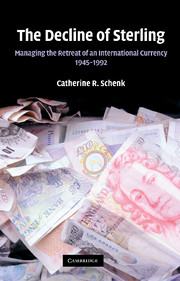Book contents
- Frontmatter
- Contents
- List of figures
- List of tables
- Acknowledgements
- 1 Introduction
- Part I Reconstructing the International Monetary System 1945–1959
- Part II Accelerating the Retreat: Sterling in the 1960s
- 4 Sterling and European integration
- 5 The 1967 sterling devaluation: relations with the United States and the IMF 1964–1969
- 6 Sterling and the City
- 7 Multilateral negotiations: sterling and the reform of the international monetary system
- 8 The Sterling Agreements of 1968
- Part III Sterling's Final Retreat 1970–1992
- Index
5 - The 1967 sterling devaluation: relations with the United States and the IMF 1964–1969
Published online by Cambridge University Press: 04 May 2010
- Frontmatter
- Contents
- List of figures
- List of tables
- Acknowledgements
- 1 Introduction
- Part I Reconstructing the International Monetary System 1945–1959
- Part II Accelerating the Retreat: Sterling in the 1960s
- 4 Sterling and European integration
- 5 The 1967 sterling devaluation: relations with the United States and the IMF 1964–1969
- 6 Sterling and the City
- 7 Multilateral negotiations: sterling and the reform of the international monetary system
- 8 The Sterling Agreements of 1968
- Part III Sterling's Final Retreat 1970–1992
- Index
Summary
The devaluation of 1967 is often interpreted as a failure of economic policy, and it has become emblematic of the inability of the Labour Party to cope effectively with the reduction of sterling's international role. It therefore constitutes a key episode in sterling's post-war retirement. On taking office in October 1964, the new Labour government discovered that the prospective deficit in the balance of payments was much worse than it had anticipated: £800 million rather than £400 million. Nevertheless, one of its first decisions was to reject devaluation as a way out of this imbalance, in favour of a supply-side modernisation of industry so as to enhance competitiveness. The Labour government's postponement of devaluation through repeated annual speculative crises in 1965 and 1966 has been widely criticised. By delaying the decision to devalue, it is argued, the prime minister, Harold Wilson, and the Chancellor of the Exchequer, James Callaghan, set in train three years of recurring speculative crises that cost the central reserves millions of dollars and required repeated emergency constraints on the domestic economy. The reluctance to change sterling's exchange rate is interpreted as arising partly from Wilson's pride (dubbed by Stewart as ‘Yorkshire obstinacy’) and partly from his fears for the political reputation of the Labour Party because of the memory of 1949. A more practical political consideration was that the Labour government had a majority of only five members, which would have made it politically very difficult to carry successfully both the devaluation and the deflationary measures that would have had to accompany it.
- Type
- Chapter
- Information
- The Decline of SterlingManaging the Retreat of an International Currency, 1945–1992, pp. 155 - 205Publisher: Cambridge University PressPrint publication year: 2010

